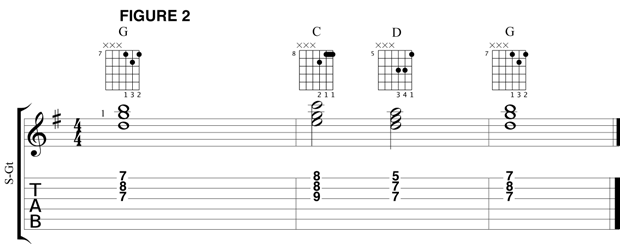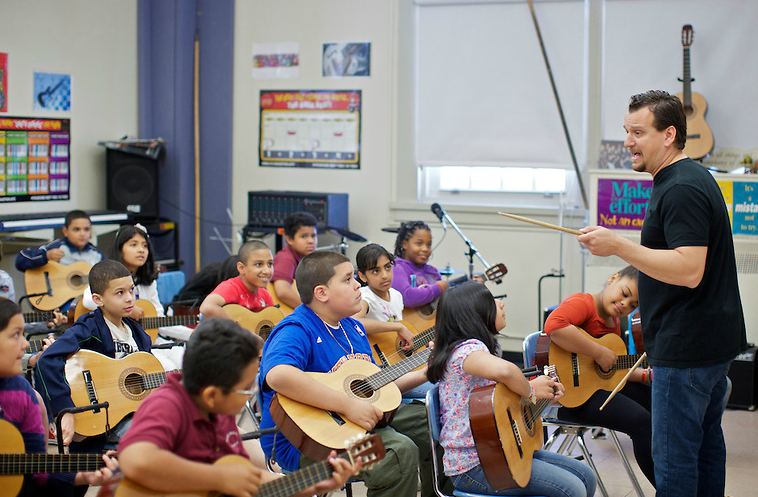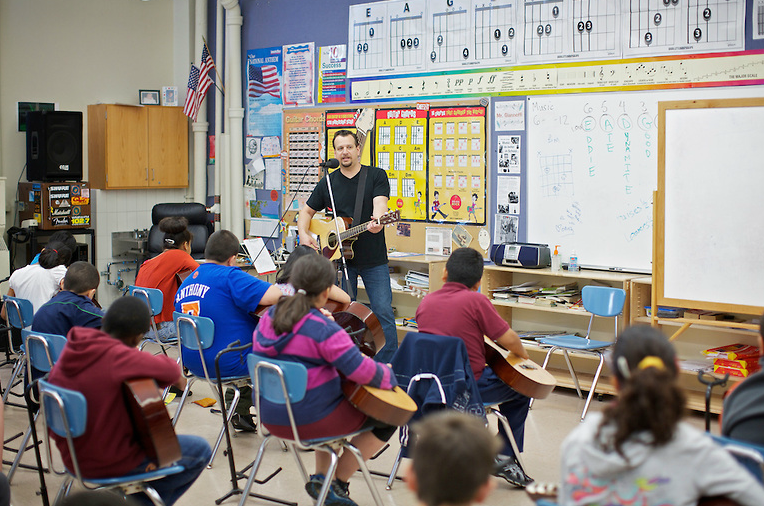VH1 Save the Music: How to Change Chords Smoothly and Explore the World Beyond the Third Fret

Hello, my name is Richard Giannotti. I teach guitar classes to middle school kids at PS 83 in Bronx, New York.
My biggest challenge on a daily basis is addressing 30-plus young teenagers at a time and maintaining their attention and focus by keeping them engaged and captivated with the subject matter at hand. In this column, I’d like to share an approach I’ve developed and taken with my students that helps keep them motivated to pay attention, practice and explore the instrument more on their own time.
The first thing I show my fifth- and sixth-grade students is how to play a handful of open chords — what are commonly referred to as “cowboy” chords — such as D, A, E, G and C. The students work very hard at being able to finger the chords correctly and cleanly, and I’ve found that the biggest challenge for them beyond that initial requirement is being able to switch from chord to chord smoothly and in time, meaning without pausing or skipping a beat (coming in too late rhythmically).
This objective can easily take up an entire school year, as we meet only once a week, about 40 times a year, with many students in the room, each of whom I need to evaluate their individual progress and help correct any bad playing habits.
When my students reach seventh and eighth grade and are more accomplished on the guitar, I like to introduce them to the world beyond the third fret. I do this by presenting the concept of a triad, which is a chord that includes only three notes and can be played in various positions and inversions on the fretboard. (An inversion refers to the ordering, or “stacking” of the notes.)
Unlike an open chord, a triad may be played without any open strings and thus can become a movable shape that may be shifted up and down the neck to any key, which makes it doubly useful. Let’s start with G, C and D triads in third and second positions (see FIGURE 1). To form the G shape, barre your fret-hand index finger across the top two strings at the third fret, pressing its fleshy pad, or “paw,” against both strings. Now press the tip of your middle finger against the G string at the fourth fret, making sure that finger does not inadvertently touch the B string.
When learning a new chord shape, it’s always a good idea to pick out each note individually and in succession, such as from low to high, to make sure you’re fretting all of them cleanly. If you hear a “dead” note—one that doesn’t ring clearly—check to make sure your fretting fingers are properly positioned on the indicated strings and frets. Once the three notes sound clear individually, strum them together to form a G triad. (Follow this same “quality control check” with all of the remaining chords in FIGURE 1.)
All the latest guitar news, interviews, lessons, reviews, deals and more, direct to your inbox!
Now let’s play the C and D triads that follow G in FIGURE 1. For C, place your index finger on the high E string’s third fret, your ring finger on the G string at the fifth fret and your pinkie on the fifth fret of the B string, as indicated. The D triad should be a familiar shape, as it is the same as an open D cowboy chord, minus the open fourth string.

FIGURE 2 presents a different set of inversions of G, C and D triads, all played higher up the neck. Notice that, while the chords are different here, the same familiar fingering shapes from FIGURE 1 are employed again, only in a different order and in different positions.

FIGURE 3 shows yet another trio of G, C and D triad inversions played even higher up the fretboard. Again, notice the familiar shapes used.

Now we’re going to take all nine of these shapes and inversions we just learned and incorporate them into a challenging and musically entertaining exercise (see FIGURE 4). Notice that the first G shape in bar 3 is the same as the D shape in bars 1 and 2, only moved higher up the fretboard. The same holds true with the D shape in bar 4 and the G shape in bar 5.

To make things interesting rhythmically, the chords are to be strummed on what are known as the eighth-note upbeats—on “one-and, two-and, three-and, four-and” in each bar, which creates a lively, reggae-like groove. For strumming, you can use either all downstrokes or upstrokes, in either case being very careful not to inadvertently strum the open D, A or low E strings.
Between each strum, momentarily loosen your fret-hand “grip” on the strings to stop them from ringing and create a brief “hole” of silence. Doing so will produce a nice, crisp staccato rhythm (short and detached) and make the figure sound like a real reggae guitar part.
You needn’t let go of the strings, however. Just relax your fingers to the point where the strings break contact with the frets. Once you’ve mastered this exercise, try with moving these triad shapes up and down the fretboard to various positions and other keys, and experiment with different rhythms too. Keep in mind that, when it comes to creating music, there are no rules! Be as creative as you like and do what sounds appealing to you.
Keep on rockin.’ — Mr. G.
Richard Giannotti teaches guitar classes to middle school kids at PS 83 in Bronx, New York.
Photo: Rob Davidson
The VH1 Save The Music Foundation is a nonprofit organization dedicated to restoring instrumental music education programs in America¹s public schools, and raising awareness about the importance of music as part of each child¹s complete education. Get involved at vh1savethemusic.org.















